Outdoor Cat Safety from Snakes: Integrating Snake Repellents In Their Environment
Hello, cat lovers! We know that feeling when our playful cats dash out the door for their daily outdoor adventures. We can’t help but fret a little bit, right? In Australia, besides climbing trees, there’s also the concern of venomous snakes in the bushes.
Take it from me; nothing makes you on edge, like picturing your precious moggie having a close shave with one of those slinky dangers. But fear not! It turns out that some snake repellents are matey with our pets.
Who knew? With these nifty solutions, we can breathe easy knowing our feline friends can keep exploring without any risky business.
After talking to experts and researching various studies, I’ve discovered effective ways to keep snakes out of your backyard without disturbing your cat.
So let’s dive into how these repellents work wonders in keeping the garden safe for prowling pussycats.
Are you eager to shield your furry sidekick from those sly invaders? Stick around as we unpack this game-changer!
Key Takeaways
- Snakes hiding in long grass, wood piles, or leaves pose a risk to outdoor cats. A bite from venomous snakes can harm cats, so creating a snake-repellent environment is crucial.
- To protect outdoor cats from snakes, you can clear debris, trim bushes and trees, and remove woodpiles and rocks. You can also use natural repellents like sulphur and garlic and rely on solar-powered snake repellers and ultrasonic devices.
- Regularly checking the property for signs of snakes, such as shed skin or presence, can help anticipate potential risks. Understanding local snake species and their habits is essential in ensuring outdoor cat safety.
Understanding Snake Behaviour and the Risks to Cats
Knowing snakes and how they act is essential to keeping our cats safe. Snakes often hide in long grass, piles of wood, or leaves. They like warm places and come out when it’s hot.
Our cats are curious and might poke their noses into snake spots without knowing the danger.
If a cat meets a snake, things can go wrong quickly. Snakes will bite if they feel scared or if they think the cat is going to hurt them. Like the common death adder, a snake bite can be very bad for your cat’s health.
Some snakes in Australia have potent venom that can harm your cat fast.
Cats use their senses to understand their surroundings. They may not initially see snakes as threats because they don’t know enough about them. We must ensure that our pets avoid dangerous areas where snakes may hide.
My job is to keep my buddy safe. I need to know where snakes are and teach my cat which areas to avoid.
Doing this decreases the possibility of my furry friend and a sneaky neighbour meeting unexpectedly.
Strategies for Creating a Snake-Repellent Environment
To create a snake-repellent environment, clear debris and minimise hiding spots. Additionally, consider using natural snake repellents like cedar oil or garlic to deter snakes from the area.
These strategies can help reduce the risk of snake encounters for outdoor cats.
<iframe width=”560″ height=”315″ src=”https://www.youtube.com/embed/Qu8LXtUkMMA?si=oNMIdHoJsN6y2jVp” title=”YouTube video player” frameborder=”0″ allow=”accelerometer; autoplay; clipboard-write; encrypted-media; gyroscope; picture-in-picture; web-share” allowfullscreen></iframe>
https://www.youtube.com/watch?v=Qu8LXtUkMMA
Clearing debris and minimising hiding spots
I want to keep my cat safe when it explores outdoors. Snakes can be a danger, but there are ways to make the garden less inviting to them.
- I always cut the grass short. It stops snakes from having good places to hide.
- Trimming bushes and trees keeps them neat. This also means there are fewer spots for snakes.
- I get rid of piles of leaves or branches. These can be perfect homes for snakes, so they need to go.
- Woodpiles near my home are a big no-no. Moving them away makes sure snakes don’t settle in close by.
- I also look for large rocks and move them out of the garden. These rocks are necessary for snakes to have fewer places to hide.
Using Natural Snake Repellents
Cleaning your yard is a good start. Adding natural snake repellents makes it safer for your cat. Some plants are known to keep snakes away because they do not like the smell or taste.
Growing these in your garden could help protect your feline friend.
You can use sulphur, clove, cinnamon oil, or vinegar around where cats hang out to keep snakes at bay.
These are strong scents that snakes prefer to avoid. You can also plant West Indian Lemongrass or garlic spray in the yard. Another option is to put the mother-in-law’s tongue plants in pots near the house.
This way, you create a barrier that smells bad to snakes but is safe for cats and people.
The Role of Snake Repellents in Protecting Outdoor Cats
To keep outdoor cats safe, use solar-powered snake repellers to keep snakes away. These repellents use vibrations or high-frequency sounds to bother snakes and keep them away from areas with cats.
<iframe width=”560″ height=”315″ src=”https://www.youtube.com/embed/Qu8LXtUkMMA?si=WwQFPT7LsildHl7s” title=”YouTube video player” frameborder=”0″ allow=”accelerometer; autoplay; clipboard-write; encrypted-media; gyroscope; picture-in-picture; web-share” allowfullscreen></iframe>
https://m.youtube.com/watch?v=K8oFtYm4QtA
Types of snake repellents available in Australia
I want to keep my cat safe from snakes. Australia has many snake repellents that can help protect our furry friends.
- Solar-Powered Snake Repellers: These devices use solar energy to charge up during the day. They send out vibrations and sounds that scare snakes away without harming the environment. Put them around your garden to create a barrier.
- Ultrasonic Snake Repellers: These gadgets make noises that humans can’t hear, but snakes don’t like. The sound messes with their sensory organs, keeping them away from your yard.
- Natural Snake Repellents: Things like sulphur, clove, and cinnamon oil are natural ways to keep snakes at bay. Spread these around your property; they smell bad to snakes but are not harmful to cats or plants.
- Commercial Snake Deterrents: You can find these at stores like Bunnings. Some come as sprays or powders you put on the ground. They have chemicals in them that snakes try to avoid.
Solar-Powered Snake Repellers and Their Effectiveness
Solar-powered snake repellers can be a game-changer in keeping our furry friends safe outdoors. These devices send out ultrasonic vibrations that snakes don’t like. Because snakes pick up on-the-ground vibrations, these solar gadgets can stop them from entering your garden, where your cat might roam.
The good thing about solar repellers is they are friendly to the environment and keep charging themselves with sunlight.
Many have found success using Solar Snake Repeller around places where dogs live or horses hang out, and they could do just as well for cat safety. Mixing different kinds of snake repellents for the best guard against these slithering pests is wise.
If you’re concerned about dangerous animals near your pet’s play area, add solar-powered lights for safety.
Let’s talk now about some additional ways to shield our cats from snake dangers outside.
More Tips for Keeping Cats Safe Outdoors
To protect your outdoor cat, check your property often for snakes and learn about local snake behavior. Watch for signs of snakes, such as shed skin or tracks, and stay informed about when snake season typically occurs in your area.
Regular property checks for snake activity
I know keeping my cat safe outdoors is a big deal. Snakes can be a real threat, so I check my yard for any signs of them. Here’s what I do:
- Walk around the edge of my property to look for broken seals or cracks in the ground. I fix them up quickly to stop snakes from slipping in.
- I take a good look at tall grass and piles of wood where snakes might hide. Cleaning these spots makes it tough for snakes to stay.
- My ears are always open for rustling sounds that might mean there’s a snake around. If I hear something, I’m extra careful to check it out.
- Checking under my house and in dark corners is also key. These fantastic, quiet places are perfect for snakes.
- Making sure my cat’s food isn’t left outside is important, too. It can attract rodents, which bring hungry snakes.
- Every few days during snake season, I spend extra time checking over everything again.
Educating yourself on snake season and local species
Learning about snake season and the types of snakes in your area is wise. You’ll better keep your cat safe knowing when snakes are most active and what kinds they are.
We have various snakes in Australia, such as those from the Elapidae family and Acanthophis antarcticus. These can be dangerous to pets.
Find out which months are snake season where you live. Then, look up the local snake species and learn their habits. This knowledge will help you see if there’s a chance for snakes to cross paths with your cat outside.
Knowing all this helps you make your home safer during peak times for snakes.
Now, we’ll discuss ways to make your home snake-free and safe for your pet.
Conclusion
In conclusion, using snake repellents outside helps protect outdoor cats from snakes. You can easily create a safer environment for cats by using practical strategies. These strategies include clearing hiding spots and using natural repellents.
Owners can protect their cats by considering how these approaches impact pet safety. Cat owners can get more help to make outdoor areas safer for their cats. They can use extra resources or ask professionals for guidance.
Using snake repellents keeps outdoor cats safe and helps pets live peacefully with nature.
FAQs
1. What is the most effective snake repellent for outdoor cats?
The most effective snake repellent is one that keeps snakes away without harming your cat. Look for safe options for pets that won’t hurt their hearing or health.
2. How can I keep my cat safe from snake bites?
To keep your cat safe from snakes, observe their behaviour outdoors and use effective pest control methods. For example, you can install gaiters and charge devices like sonic repellents.
3. Are all snakes dangerous to cats?
Not all snakes are dangerous to cats, but some, like mambas and eater brown snakes, have venom that can be very bad if they bite your pet.
4. Can I use rechargeable snake repellents for my cat’s safety?
Yes! Using a rechargeable snake repellent is good because it saves you from buying batteries often. Just make sure it’s not corrosive or unsafe near your cat.
5. Will feeding my cat indoors help keep them safe from snakes?
Feeding your cat indoors may reduce their hunting behaviour outside and their chances of encountering snakes.

Jennifer Mornard is the owner of a backyard farm in Calaveras County. She keeps her garden pest-free by using organic and inorganic methods and keeping it clean. She also tests pest control products to keep snakes, gophers, and other pests away.
Jennifer has worked and study reptiles around the globe including Africa, Asia, Australia and in the open prairies, grasslands deserts in USA. It is her mission to provide a solution for reptiles, manly snakes, and human beings to co-exist. Her goal is to educate people so they can prevent the unpleasant experience of snakes and humans crossing paths in people homes and properties.


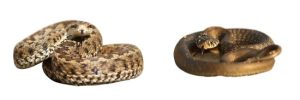 How to Tell if a Snake is Poisonous
How to Tell if a Snake is Poisonous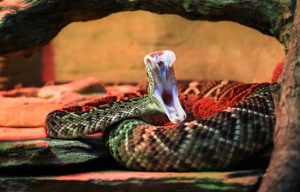 pattern. Found in the Southeastern US, Eastern Louisiana, Southern Mississippi, coastal plains of North Carolina and in Florida. It is a thick set snake and can get to 8 feet long and over 30 pounds. They are considered to be the most venomous snake in US but they move a bit slow in comparison to other snakes due to their thick body. Of course they are a rattlesnake and are identified by the diamond patterns running along its back. It also has black band covering its eyes. Another distinction is it has cat eye pupils and a large pit between the nostrils. They can be black, brown with cream diamonds or even yellow.
pattern. Found in the Southeastern US, Eastern Louisiana, Southern Mississippi, coastal plains of North Carolina and in Florida. It is a thick set snake and can get to 8 feet long and over 30 pounds. They are considered to be the most venomous snake in US but they move a bit slow in comparison to other snakes due to their thick body. Of course they are a rattlesnake and are identified by the diamond patterns running along its back. It also has black band covering its eyes. Another distinction is it has cat eye pupils and a large pit between the nostrils. They can be black, brown with cream diamonds or even yellow.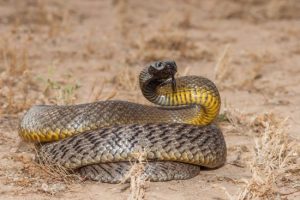 nland Taipan: Also known as the “fierce snake,” it has the most toxic venom of any snake in the world. This snake is a medium to large snake a broad build and a deep rectangular-shaped head. Their colors range from pale fawn to yellowish – brown to dark brown. The head and the neck is usually darker than the body.
nland Taipan: Also known as the “fierce snake,” it has the most toxic venom of any snake in the world. This snake is a medium to large snake a broad build and a deep rectangular-shaped head. Their colors range from pale fawn to yellowish – brown to dark brown. The head and the neck is usually darker than the body.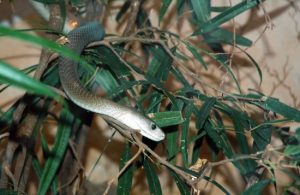 coloring can range from Gray to dark brown and the underside is lighter. The snake is not black on the outside, the black is actually inside its mouth. This snake is found in the Rocky Savannas and the lowland forest in Africa.
coloring can range from Gray to dark brown and the underside is lighter. The snake is not black on the outside, the black is actually inside its mouth. This snake is found in the Rocky Savannas and the lowland forest in Africa.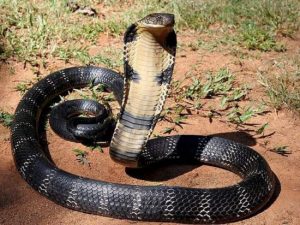 King Cobra: The world’s longest venomous snake, with a unique, intimidating appearance. The coloring is either Yellow, Green, Brown or Black with alternating chevron banding along their bodies. Their head is larger that other Cobra’s. They are generally shy and don’t bother humans but they are very poisonous. They are found They are found Western Indonesia, Philippines, Hong Kong and Southern China. They like open or dense forest, thickets,agriculture areas and mangroves.
King Cobra: The world’s longest venomous snake, with a unique, intimidating appearance. The coloring is either Yellow, Green, Brown or Black with alternating chevron banding along their bodies. Their head is larger that other Cobra’s. They are generally shy and don’t bother humans but they are very poisonous. They are found They are found Western Indonesia, Philippines, Hong Kong and Southern China. They like open or dense forest, thickets,agriculture areas and mangroves.